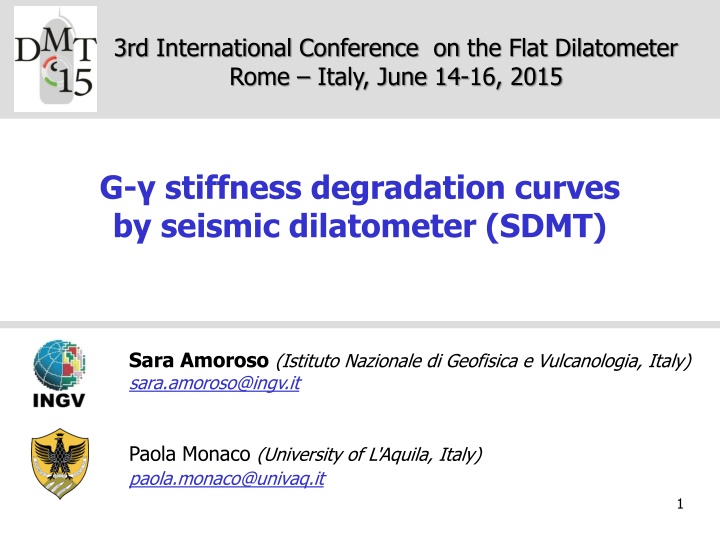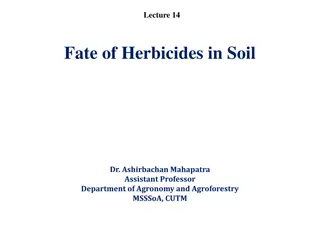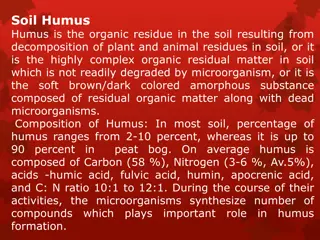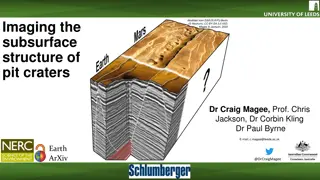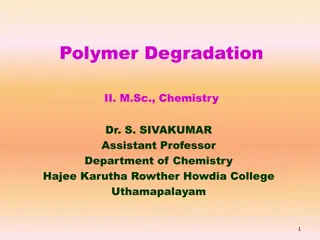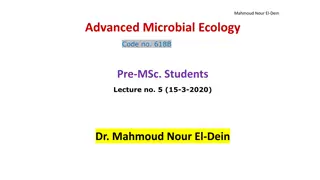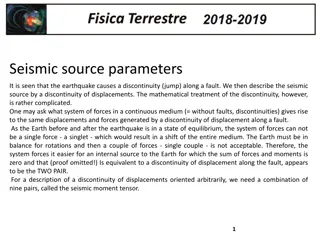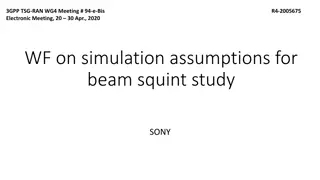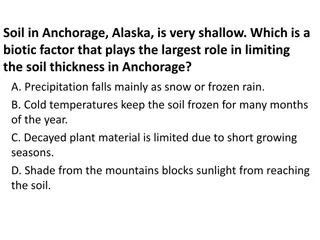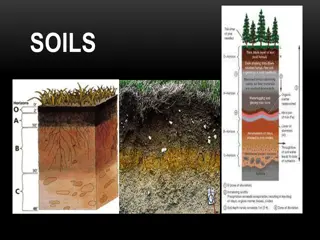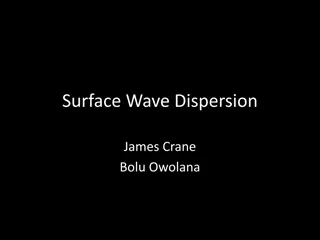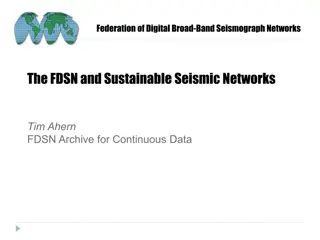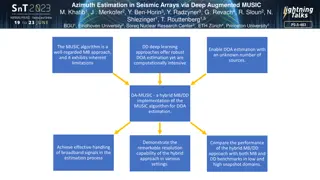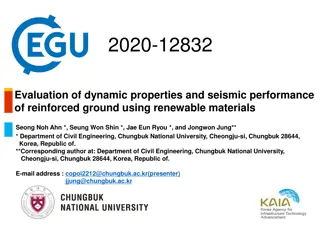Insights into Soil Stiffness Degradation Using Seismic Dilatometer Data
This content discusses the analysis of soil stiffness degradation curves using data collected from the Flat Dilatometer and Seismic Dilatometer tests. Researchers Sara Amoroso and Paola Monaco present methods for deriving in situ G- decay curves and evaluating shear strain data in various soil types. Case studies from Treporti and Texas demonstrate the practical application of combining in situ and laboratory techniques to understand soil behavior. The content also includes a discussion on the evaluation of soil stiffness decay under different test conditions.
Download Presentation

Please find below an Image/Link to download the presentation.
The content on the website is provided AS IS for your information and personal use only. It may not be sold, licensed, or shared on other websites without obtaining consent from the author.If you encounter any issues during the download, it is possible that the publisher has removed the file from their server.
You are allowed to download the files provided on this website for personal or commercial use, subject to the condition that they are used lawfully. All files are the property of their respective owners.
The content on the website is provided AS IS for your information and personal use only. It may not be sold, licensed, or shared on other websites without obtaining consent from the author.
E N D
Presentation Transcript
3rd International Conference on the Flat Dilatometer Rome Italy, June 14-16, 2015 G- stiffness degradation curves by seismic dilatometer (SDMT) Sara Amoroso (Istituto Nazionale di Geofisica e Vulcanologia, Italy) sara.amoroso@ingv.it Paola Monaco (University of L'Aquila, Italy) paola.monaco@univaq.it 1
Tentative method for deriving in situ G- decay curves from SDMT SDMT small strainmodulus G0 from VS working strainmodulus GDMT from MDMT (track record DMT-predicted vs. measured settlements) ? But which associated to GDMT ?
Shear strain " DMT" Quantitative indications by comparing at various test sites and in different soil types SDMT data + reference stiffness decay curves: back-figured from the observed behavior under a full-scale test embankment (Treporti) or footings (Texas) obtained by laboratory tests (L'Aquila, Po plain, Fucino plain) reconstructed by combining different in situ/laboratory techniques (Western Australia) same-depth "reference" stiffness decay curve
Treporti Test Site Embankment 1 1 z = 13.2 m z = 15.2 m KE/KE0 KE/KE0 z = 8-20 m SILT z = 2-8 m SAND 0.8 0.8 z = 12.1 m In situ curves at various z (b) (a) z = 10.1 m z = 7 m z = 11.1 m z = 14.2 m z = 16.3 m z = 8 m 0.6 0.6 z = 18.3 m Intersection of DMT ordinate with in situ curve at same z z = 9 m z = 5.9 m 0.4 0.4 z = 4.9 m z = 17.3 m DMT DMT 0.2 0.2 z = 19.4 m z = 2.9 m z = 3.9 m 0 0 0.00001 0.0001 0.001 0.01 0.1 1 v(%) 10 0.00001 0.0001 Monaco et al. (2014) 0.001 0.01 0.1 1 v(%) 10 ( ) ( ) ) + 1 2 1 1 M = DMT E E = KEpa( 'v /pa)0.5 ( DMT Normalized decay curves of soil stiffness with vertical strain back-calculated from local v measurements in the soil under the embankment, at 1 m depth intervals, provided by sliding deformeters ("In situ curves") and their intersection with data points corresponding to same-depth DMT moduli EDMT: (a) sand 2-8 m, (b) silt 8-20 m 4
Texas A&M University National Geotechnical Experimentation Site 1994 Spread Footing Prediction Symposium 1 1 Gibbens & Briaud (1994) Berardi (1999) medium dense silty fine sand normalized Young modulus, E'/E0 Footing 3 m x 3 m Footing 2 m x 2 m Footing 1.5 m x 1.5 m Footing 1 m x 1 m 0.8 0.8 0.6 0.6 EDMT/E0 0.4 0.4 from DMT and Cross Hole: w/B 0.25 - 0.45 % 0.2 0.2 0 0 0 0 1 1 2 2 3 3 4 4 5 5 relative displacement, w/B (%) Stiffness decay curve E'/E0 vs. relative displacement w/B (Berardi 1999)and superimposed EDMT/E0 data points 5
L'Aquila 2009 Post-Earthquake Investigations C.A.S.E. Project Test Sites Santucci de Magistris et al. (2013) 1 2 1 Laboratory G/G0- curves and superimposed GDMT/G0 data points = G M ( ) DMT DMT 2 RC-CTS: UniNA Federico II (Italy) DSDSS: UniRoma La Sapienza (Italy) 6
Po plain 2009 Post-Earthquake Investigations San Carlo (FE) 1.2 GDMT/G0 from SDMT: g DMT 0.07-0.47 % Working Group S2-UR4 (2013) normalized shear modulus, G/G0 1.0 0.8 RC - S2 CI2 RC - S3 CI3 RC - S10 C1 RC - S11 C1 RC - S11 C2 RC - S11 C3 GDMT/G0 S2 CI2 GDMT/G0 S3 CI3 GDMT/G0 S10 C1 GDMT/G0 - S11 C1 GDMT/G0 - S11 C2 GDMT/G0 - S11 C3 0.6 0.4 0.2 0.0 0.00001 0.0001 0.001 shear strain, g (%) 0.01 0.1 1 10 1 2 1 Laboratory G/G0- curves and superimposed GDMT/G0 data points = G M ( ) DMT DMT 2 RC-CTS: undisturbed samples in silty sand, silt and clay 7
Fucino plain National Geotechnical Research Site 1.2 Burghignoli et al. (1991) normalized shear modulus, G/G0 RC - z = 5-30 m GDMT/G0, z = 5 m, 10 m GDMT/G0, z = 15 m GDMT/G0, z = 20 m GDMT/G0, z = 25 m, 30 m 1 0.8 0.6 0.4 GDMT/G0 from SDMT: g DMT 1.10-1.70 % 0.2 0 0.0001 0.001 0.01 0.1 1 10 shear strain, g (%) 1 2 1 Laboratory G/G0- curves and superimposed GDMT/G0 data points = G M ( ) DMT DMT 2 RC-CTS:12 undisturbed samples recovered between 3-37 m 8
Western Australia Various test sites 1.2 1.2 1.2 1.2 G/G0 S henton Park BH1A, z = 1.3 m G/G0 S henton Park BH2A, z = 1.3 m G/G0 S henton Park BH2B, z = 2.3 m G/G0 S henton Park BH3A, z = 2.3 m G/G0 S henton Park BH2C, z = 3.3 m G/G0 S henton Park BH3B, z = 3.3 m G/G0 S henton Park BH1B, z = 3.3 m G/G0 S henton Park BH2D, z = 3.9 m G/G0 S henton Park BH1C, z = 4.3 m G/G0 S henton Park BH3C, z = 4.6 m G/G0 Ledge Point BHB, z = 1.3 m G/G0 Ledge Point BHB, z = 3.3 m GDMT/G0 S henton Park BH1A, z = 1.3 m GDMT/G0 S henton Park BH2A, z = 1.3 m GDMT/G0 S henton Park BH2B, z = 2.3 m GDMT/G0 S henton Park BH3A, z = 2.3 m GDMT/G0 S henton Park BH2C, z = 3.3 m GDMT/G0 S henton Park BH3B, z = 3.3 m GDMT/G0 S henton Park BH1B, z = 3.3 m GDMT/G0 S henton Park BH2D, z = 3.9 m GDMT/G0 S henton Park BH1C, z = 4.3 m GDMT/G0 S henton Park BH3C, z = 4.6 m GDMT/G0 Ledge Point BHB, z = 1.3 m GDMT/G0 Ledge Point BHB, z = 3.3 m G/G0 Perth CBD, z = 9.45 m G/G0 Perth CBD, z = 10.65 m G/G0 Perth CBD, z = 12.05 m G/G0 Perth CBD, z = 13.35 m G/G0 Perth CBD, z = 15.20 m G/G0 Perth CBD, z = 16.70 m GDMT/G0 Perth CBD, z = 9.45 m GDMT/G0 Perth CBD, z = 10.65 m GDMT/G0 Perth CBD, z = 12.05 m GDMT/G0 Perth CBD, z = 13.35 m GDMT/G0 Perth CBD, z = 15.20 m GDMT/G0 Perth CBD, z = 16.70 m SAND G/G 0 (Vs) from SCPT SILTY CLAY G/G 0 (Vs) from SCPT normalized shear modulus, G/G 0 normalized shear modulus, G/G 0 SILICA SAND CALCAREOUS SAND 1 1 1 1 0.8 0.8 0.8 0.8 0.6 0.6 0.6 0.6 G/G 0 from SBP (J ardine, 1992) and 0.4 0.4 0.4 0.4 G DMT/G 0 from DMT and SCPT gDMT 0.43-1.90 % G DMT/G 0 from DMT and SCPT gDMT 0.04-0.15 % G/G 0 from SBP (J ardine, 1992) and 0.2 0.2 0.2 0.2 0 0 0 0.0001 0.0001 0 0.0001 0.0001 0.001 0.001 0.01 0.01 0.1 0.1 1 1 10 10 (a) (b) 0.001 0.001 0.01 0.01 0.1 0.1 1 10 1 10 shear strain, g (%) shear strain, g (%) In situ G/G0- decay curves and superimposed GDMT/G0 data points: (a) Shenton Park (siliceous sand) and Ledge Point (calcareous sand) (b) Perth CBD (silty clay) (Amoroso 2011) 9
Western Australia Various test sites 1.2 1.2 1.2 1.2 G/G 0 (Vs) from SDMT G/G 0 (Vs) from SDMT Gs/G0 Margaret River z = 6 m Gs/G0 Margaret River z = 9 m GDMT/G0 Margaret River z = 6 m GDMT/G0 Margaret River z = 9 m Gs/G0 East Perth z = 16 m GDMT/G0 East Perth z = 16 m normalized shear modulus, G/G0 normalized shear modulus, G/G0 1 1 1 1 0.8 0.8 0.8 0.8 G/G0 from triaxial tests and SDMT (Atkinson, 2000) 0.6 0.6 0.6 0.6 G/G0 from triaxial tests and SDMT (Atkinson, 2000) 0.4 0.4 0.4 0.4 0.2 0.2 GDMT/G0 from SDMT gDMT 5.50 % 0.2 0.2 GDMT/G0 from SDMT gDMT 0.36-1.75 % 0 0 0 0.0001 0.0001 0 0.0001 0.0001 0.001 0.001 0.01 0.01 0.1 1 1 10 10 100 100 0.1 0.001 0.001 0.01 0.01 0.1 0.1 1 1 10 10 (a) (b) shear strain, g (%) shear strain, g (%) In situ G/G0- decay curve and superimposed GDMT/G0 data points: (a) East Perth (soft clay), Margaret River (silty clay) (Amoroso 2011) 10
Typical ranges of DMTin different soil types "Typical shape" G/G0- curves in different soil types Amoroso et al. (2014) Range of values of GDMT/G0and corresponding shear strain DMT determined by the "intersection" procedure in different soil types
Tentative equation for deriving G/G0- curves from SDMT SDMT data points used to assist construction of hyperbolic equation 1 G = G G + 0 1 1 0 G DMT DMT Roio Piano L'Aquila Comparison between G/G0- decay curves obtained in Lab and estimated from SDMT by hyperbolic equation DSDSS (Double Sample Direct Simple Shear tests): University of Roma La Sapienza Amoroso et al. (2014)
Numerical site seismic response analysis Schematic plot (1D) & typical results TIME DOMAIN RESPONSE FREQUENCY DOMAIN RESPONSE INPUT GROUND MOTION (rock outcrop) OUTPUT GROUND MOTION (ground surface) Period, T HORIZONTAL SOIL LAYERS (1D model) DEPOSIT BEDROCK SDMT 13
Validation of in situ G- decay curves from SDMT (under study) Comparison between HSS model PLAXIS from SDMT parameters and monitoring activities for the excavation of Verge de Montserrat Station (Barcelona, Spain) Working group: Amoroso, Arroyo, Gens, Monaco, Di Mariano
Validation of in situ G- decay curves from SDMT (under study) Oedometric modulus Eoed(MPa) HSS model PLAXIS 0 20 40 60 80 100 0 ( ) 5 m = ' ref 0 ref G G p 0 1 10 Assumptions: = = = / 4 M E E E 50 DMT oed ur 15 1.2 GDMT/G0 Hyperbolic curve normalized shear modulus, G/G0 VERGE MONTSERRAT UG4 Sand Depth (m) 20 1 25 0.8 G/G0 = 0.722 0.6 30 0.4 35 Eoed from SDMT (Eoed=Mdmt) Eoed from HSS model (PLAXIS) 0.2 40 0.7 0 1.00E-04 1.00E-03 1.00E-02 shear strain, (%) 1.00E-01 1.00E+00 1.00E+01 45
Validation of in situ G- decay curves from SDMT (under study) Preliminary results show an acceptable agreement between experimental data (monitoring activities) and numerical analysis (based on SDMT data) Diaphragm wall horizontal movement (mm) -10 -5 0 5 10 0 5 10 Depth (m) Phase 9 Pumping down to a depth of 10 m 15 20 25 30 Working group: Amoroso, Arroyo, Gens, Monaco, Di Mariano OBSERVED NUMERICALANALYSIS 35 40
Concluding remarks SDMT results could be used to assess the decay of in situ stiffness with strain level and to provide guidance in selecting G- curves in various soil types, thanks to its ability to provide both a small strain modulus (G0from VS) and a working strain modulus GDMT(obtained from MDMT derived by usual DMT interpretation) Use of proposed hyperbolic relationship, which requires to input ratio GDMT/G0+ presumed "typical" shear strain DMT for a given soil type, can provide a useful first order estimate of G/G0- curves from SDMT (further validation needed)
